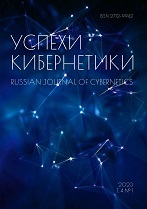|
Single-well capacitance resistive model (CRM) for analyzing well watercutting by formation water in highly permeable reservoirs
S. G. Volpina, I. V. Afanaskinb, D. V. Solopova, Yu. B. Chen-len-sona
a Federal State Institution “Scientific Research Institute for System Analysis of the Russian Academy of Sciences”, Moscow, Russian Federation
b Moscow, Russian Federation
Abstract:
This article presents a single-well Capacitance Resistive Model (CRM) developed by the author for analyzing well flooding by peripheral water in highly permeable formations. The introduction briefly discusses various types of CRM models, including CRMT, CRMP, CRMIP, CRM Omega, CRMs, CRM-Block, ML-CRM, and the modified CRMT-M, CRMP-M, and CRMIP-M versions. The key advantage of CRM models is the omission of reservoir pressure in calculations. It is replaced with a ratio involving bottomhole pressure, fluid flow rate, and productivity factor, determined by well design. The article focuses on a simulation model for predicting bottomhole pressure and fluid flow rate in single wells experiencing peripheral water flooding. It provides equations for calculating bottomhole pressure at a given fluid flow rate, fluid flow rate at a given bottomhole pressure, average saturation in the drained volume, saturation on the well wall, water cut, oil and water flow rates, and water inflow from the aquifer. Additionally, empirical formulas for average saturation in the drained volume are presented. A field example from the Timan-Pechora oil and gas province is examined. The model can estimate drainage volumes and productivity coefficients. We also constructed predictive models for bottomhole pressure, fluid flow rate, average saturation, and watercutting. The results indicate differences in predictive accuracy based on the distance of wells from other operating wells and the selected saturation models.
Keywords:
CRM model, development analysis, well watercutting, development forecasting, elastic pressure regime, aquifer, material balance.
Citation:
S. G. Volpin, I. V. Afanaskin, D. V. Solopov, Yu. B. Chen-len-son, “Single-well capacitance resistive model (CRM) for analyzing well watercutting by formation water in highly permeable reservoirs”, Russian Journal of Cybernetics, 5:2 (2024), 13–25
Linking options:
https://www.mathnet.ru/eng/uk151 https://www.mathnet.ru/eng/uk/v5/i2/p13
|

| Statistics & downloads: |
| Abstract page: | 9 | | Full-text PDF : | 4 | | References: | 4 |
|




 Contact us:
Contact us: Terms of Use
Terms of Use
 Registration to the website
Registration to the website Logotypes
Logotypes








 Citation in format
Citation in format 